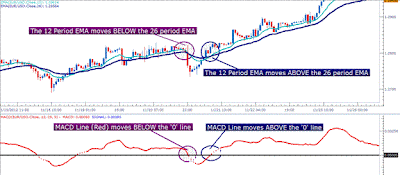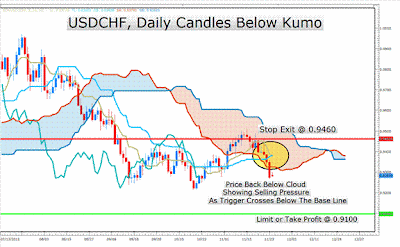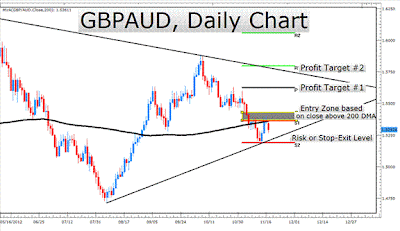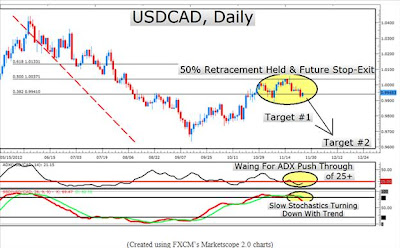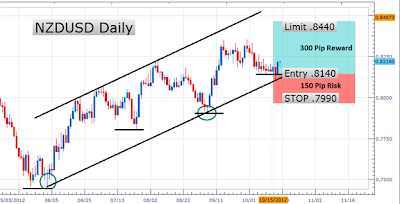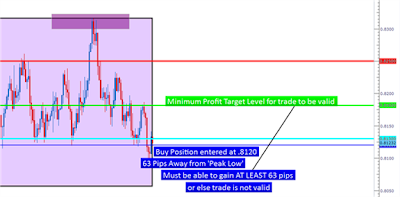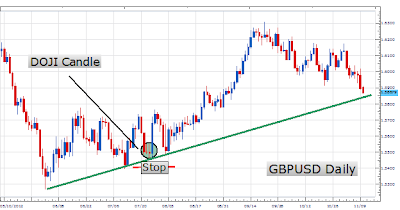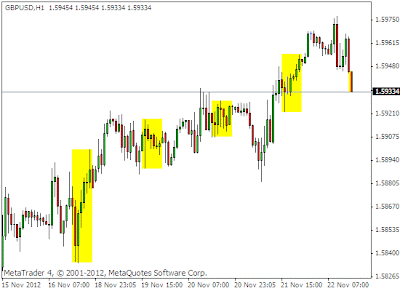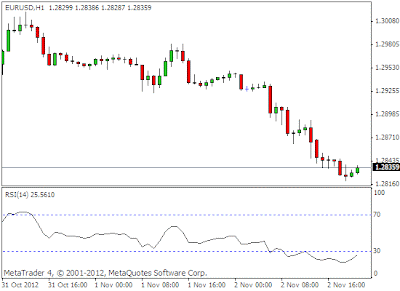Thursday, December 6, 2012
How to Trade Using MACD indicator
We will then move on to find at systems that Forex traders can find to trade with MACD histogram in our next post, simple trading system using MACD momentum indicator.
What build up Moving Average Convergence Divergence ?
Moving average convergence divergence is very simple trading indicator, this indicator calculates 2 EMA indicator. The default settings for MACD indicator are calculating Exponential Moving Average of 12, and 26 periods and the signal line of 9 periods moving average indicator.
In bearish markets, the fast MA will trade bearish faster than the slow MA indicator. As the fast MA indicator diverges from the slow MA indicator. And in bullish markets, the 12 Exponential moving average will trade bullish faster than the 26 period Exponential moving average. Moving Average Convergence Divergence trade higher to express this moving difference between 12 MA and 26 MA indicator. The following chart will show this situation, with the 12 period exponential moving average and 26 period exponential moving average traded on the graph along with Moving Average Convergece Divergence using 12 and 26 exponential moving average.
MACD forex indicator helps traders to determine the market trend change, as the blue boxes in the image above began before the bearish trend was finished.
The 0 line is a main section of the MACD, as it tells us when there is no difference between the Exponential moving averages. Moving average convergence divergence will cross the 0 line as the fast MA indicator crosses the slow MA indicator.
Moving average convergence divergence can be helpful for determining trend reversal at the beginning. When we wait zero line crossover, we're trading a MA indicator crossover. The signal is only a MA indicator made on the MACD indicator line, and this value is usually set at 9 periods moving average.
Usually forex traders will find for trading chances if MACD indicator intercepts the signal line. And if MACD indicator line intercept above and over the signal line, it is called long signal and if MACD indicator intercept under the signal line, it called at as a short signal.
The MACD histogram
The MACD histogram is the relationship between the Moving Average Convergence Divergence and signal lines, Forex traders can use the MACD histogram , which is only a bar around the zero line.
in the following chart - when MACD indicator intercepts the signal line, the histogram will cross the zero line. If MACD crosses above and over the signal line, the histogram will move up from the zero line and if MACD indicator intercepts below the signal line the MACD histogram will move below the zero line.
The MACD default settings are 12, 26 and 9. These settings can make too many trading signals. Forex traders searching to take trading signals from MACD indicator.
Wednesday, December 5, 2012
Range Trading with RSI Indicator
In this article we can find an example chart of a range market. Support level is made by connecting a series of market lows. Resistance level is made by connecting a series of market highs. With these range areas we can then proceed with range trading plan to long or short at these specific price levels. To better entries we will be using RSI Forex indicator.
Relative Strength Index is a great indicator, this indicator can be traded in both range and trending market. Momentum is key and we can see on the following Forex chart that the previous RSI signal gave us to short resistance as Relative strength index traded from overbought areas. As market price trading bearish Forex traders can find for a right signal to buy the currency pair at support if Relative strength index indicator becomes oversold.
Range traders like trading in a Forex market without a clear market prediction. Forex traders can long and short between resistance and support levels until market price breaks the support or resistance level. Since there is a chance of a breakout, range trader set a stop when trading. They set stop orders outside of support when long or resistance when short.
Using the Relative strength index with the graph, my suggestion is to short the currency on a reverse from overbought areas. New positions cam target range support with stop loss level plotted above of resistance level. Profit target could be plotted close support.
Tuesday, December 4, 2012
How to trade Ichimoku Indicator ?
The ichimoku clouds let us to identify the market price action. How to trade Ichimoku Kinko Hyo trend indicator
Buy entry
- If the kumo cloud is under the market price.
- Kikun sen is bellow tenkan sen
- Market price action is below chikou line
- Entry trade isn't more than 150 pips away from the tenkan sen.
Ichimoku Trading example
The Ichimoku trend indicator presents a strong signal to short position as market price trade reverse under the cloud. Market price has been bellow the cloud. We also notice that the tenkan sen is pending a cross under the kijun sen which gives a bearish or sell opportunity. The rejection of the bullish move in the middle of the cloud gives a opportunity to open short position in the way of the market trend.
The Ichimoku Kinko Hyo is great trend indicator, another important component of ichimoku kinko hyo indicator is the chikou span. The chikou span is the teal line which is last market price plotted back 26 periods. The purpose of Chikou is to bring you a picture of whether or not market price is lower or higher than it was 26 days on month ago.
When the chikou is traded above the cloud, it is uptrend for the forex pair. The trigger line is also above the chikou even the market price touched and reversed the chikou line before.
Monday, December 3, 2012
Triangle Pattern Trading Example
A great thing about triangle chart pattern trading is that our risk is determined based on main price action. In the following chart we can see the price levels that we want to concern on should the triangle continue to play course.
We can see the 200 MA and pivot point to assist us determine the risk on the transaction. The 200 MA is plotted as a support or resistance level for most traders. This mean that the foreign exchange market wouldn't push you to open long position if market price is under the 200 MA.
On the market graph above we can notice the 200 MA separating market price down the middle. We can find to transaction back to the top of the triangle chart pattern if market price as crossed and closed above the 200 MA. You should not take a risk until the 200 MA Moving average indicator is below the market price.
Market price is under the 200 MA and stay at 1.5361. We can use an entry order to open trading position if market price touches this price level. We also use the pivot point levels that market price has respected in light of the triangle chart pattern. If you are not familiar with pivot point trading system, they are made from the first to the last of the current month based on last month's market price action. There are so many Foreign exchange traders use pivot point levels with chart pattern to assist them determine entry levels.
The second price level of support (S2) align with the rising triangle when you see a bullish engulfing pattern. We can use this as a stop loss level and plot our risk under the 2nd support because market price refused moving under this support level before.
We now have a determined entry with the 200 MA trend indicator. We have a risk level plot under the second support level which is built the ascending triangle chart patter. And then we will find at reliable targets.
The MA trend indicator is trade 175 points from the second support price level. And we have to look for a target at least 200 points. The pivot points level is at 1.5630 or 266 points from the target. We can also set our target at the highest of the triangle chart pattern.
Sunday, December 2, 2012
ADX Best Trend Indicator
The currency chart above shows a bullish trend with multiple trades as the Average Directional Movement index trend indicator on the bottom presents a main of reading above the strong trend. The red line as a reference level of when the tool presents a strong market trend. To determine the trend strength, we suggest searching for trend entry only if the Average Directional Movement Index is above level 25.
Average Directional Movement Index trading rule
When moving trends, the Average Directional Movement Index Moves above when market is in strong market. When the market trend is fade , Average directional movement index moves bearish.
Average directional movement index isn't a directional technical indicator, just a strength indicator.
If you are searching for trend bias, I suggest using indicator to search reversals in the trend direction of the market trend or breakouts trading with the Average directional movement index. this will give bigger chance set ups with a strengthening trend.
Trading in strong market trends
- We can set up the risk but not the market.
- Just trading the bigger chance set ups that match your trading system
- Trading with Average Directional movement index lets you to identify a last potential trade to see if the entry is worth the risk.
- ADX id the indicator we will use to identify whether a bearish move is worth trading on a short trade. Average directional movement index also be traded in the same situation to grasp if an move is worth trading on a long trade. Either system the Average directional movement index will break through 25 level to show us that a strong trend is in market.
Chart example above shows us the strong bearish move
Here are the indicators at set on the graph above :
- Average directional movement index for determining market strength
- Fibonacci retracement for identify support in a bearish trend
- Stochastic indicator for determining overbought or oversold reversal.
We will analyze on the ADX indicator to trade through 25 level. If the ADX indicator breakout through 25, we have the indicator's signal to trade in the direction of the market trend. The instrument above trend on the D1 graph is bearish. Because the ADX indicator is not move yet. Fibonacci is a favorite tool to determine right levels to determine reversal move. Support level in a bearish trend is potentially at one of these price levels and if the instrument bounces off these points we can search to enter off that resistance level in a bearish trend.
A popular level is the 50% level. If the instrument can not keep 50% of its trade, then it may break down and reverse the overall trend. We can see above that the Forex market kept the 50% and is searching to trade bearish. When the average directional movement index or ADX indicator trades through we have another confirmation.
The stochastic trading indicator calculates a instrument closing price to its range over a given period. The 20 level gives an oversold area and the 80 level presents an overbought situation. We can set up the Stochastic's time period to eliminate the false signals to market movements. During a bearish trend to close near their lows. Slow stochastic indicator signal show in a bearish trend if the stochastick indicator reverses bearish below 80 level after a temporary bullish swing in the currency market. This gives bigger chance entries.
The ADX indicator calculates trend strength, and lets you to combine the other technical indicators to make sure you are only trading the strong trends. This trading system can hold you out of risky markets if your analyze is allowing your target run on a trend.
Tuesday, November 27, 2012
How to Trade False Breakout
As a forex trader, we we must know how to determine a false breakout. Many forex participants force trend entries position if a breakout formed even though the Forex market has no intention of respecting that breakout pattern. Any trend trader sometimes entering into worse trade if they prematurely traded into a market.
In this article you will learn about how to see if a breakout is fake or if you should trade the breakout market and take advantage. This post will assist you to take benefit of false breakouts. And here are the indicators we will use to trade with false breakout.
- ATR Indicator (14 periods)
- Candlestick pattern analysis
- Support and resistance levels
This article will help you to take advantage of false breakouts that experienced traders love to trade and that trap new traders.
Here are the tools we'll use to protect ourselves against getting trapped into a false breakout.
Average True Range (14 periods)
Support & Resistance
Candlestick Analysis
ATR Indicator 14 Periods
The ATR indicator shows you the volatility by calculating daily fluctuations. We can apply Average True Range indicator to check the reality of a breakout if market price trades support and resistance. Average true range is use to identify the number of points the range must be broken by before we trade into the market or choose to not trade the breakout.
For instance, the Average True Range 14 periods for pair is 114.6 pips. This shows us that the currency is 2x more volatile in pip terms than AUD USD. We would find for a breakout pattern from a range above 68 points and 114.5 points before we trade with the market trend. If this does not form we find to take a trade back into the newly expanded range with a better money management strategy.
If market price does not break the range by the average true range, the breakout is fake and we should leave. If the currency trades trough by more than the Average True Range then we are searching at a main trend to trade that should now be on our concern.
Support and resistance
Resistance level is the ceiling that market price reaches before going back to the range. Support is the floor that price reaches before reversing back up. Forex traders should focus on support and resistance because the forex market focuses on support and resistance too. If a new market trend breaks out to the upside range, then what was resistance now becomes support level.
Trading with support and resistance do not need an forex technical indicator but an experience to see at the graph and see when buyers stop buying in a bullish trend and vice versa.
How to use support and resistance level in false breakout trade? if we identified a false breakout below support level, we can open long position near support. Many experience traders know that trading ranges is a low risk and even though that following trends is tempting but has bigger risk trade out.
Candlestick Analysis
Candlestick pattern can shows you real time forex market sentiment so that we can determine trading bias as they're developing. Market sentiment is necessary for us to know so we can see when sellers are heading for the exits when a supposed downside breakout occurs. And you can find at candlestick around resistance to see if buyers have lost strength and aren't willing to keep on their trading position.
The candlestick signals here are bearish and bullish engulfing candlestick patterns which are these very significant reversal signals on the graph. Candlestick formations take on a significant around resistance and support levels or against pivot point lines or Moving Average indicator levels because this is where sentiment of Foreign exchange traders are key.
Understanding of fake breakouts and how to ride them with Average True Range, candlestick analysis and support or resistance levels can add a lot of benefits to your trading system. You should be patient and when we look market price signaling you to a false breakout or a new market trend, we will understand how to face it with confidence.
How to Read 200 SMA Indicator
200 SMA technical indicator is one of the most favorite indicators in the Forex trading. This tool can be found on the graph of many hedge funds and market makers as a main indicator. Few technical methods can be as necessary to a forex trader as resistance and support. And while there are many systems of searching important levels, few are as interesting as the 200 SMA for the very reason we told at the first of this post : the significant for a self fulfilling analysis to take place as Forex traders react by open short position if market price resists at the 200 SMA, or open long position if market price is supported by the 200 SMA.
Forex traders can find level stops under these points if searching to trade in the trend direction. In the chart above, upon noticing that market price had tested of the 200 SMA, Forex traders could find to open buy position with a risk under the 200 Simple Moving Average. So, when market price doesn't trade higher, the Forex trader can find to exit the trade before the loss getting bigger to an undesirable price. The chart below will describe this strategy in more detail :
One of the main desires of such a system is the thought that the Forex trader could be able to take in the trade in the trend direction. After all, if market price is trading bearish to the 200 SMA, then market price is trading bearish after having previously traded above that price; indicating that the market trend was previously to the uptrend. This gives us to other usage of the 200 Simple Moving Average; as a indicator to identify market trends.
The 200 SMA as a trend filter
Market price has crossed the 200 SMA only once in 2012 on Euro Dollar. Market price traded just six such crosses in 2011, over 3 different examples; many of which were followed by an extended move in the currency instrument in that trend direction. The chart below will describe in more clearly :
Each example of crossover trading was followed by a corresponding extended trade, with sizes of those trades indicated in the following graph
200 SMA Simple Moving Average trading system
Forex trader can make trading systems with 200 Simple Moving Average. as was seen chart above, market price may trade for an expanded time after crossing the 100 simple moving average. so, if market price trades above the 200 simple moving average, forex trader can find to open buy position with a stop loss at the moving average line. With this, when market price does pull back then the forex trader can contain the loss to a palatable price. Another way, if market price trades under the 200 SMA, forex traders can search to open sell position or setups as a trend filter.
For example a Forex trader wanted to trade with Relative Strength Index. Well, traders can do so by filtering trades to just take entries that agree with the 200 SMA. So, when market price is above the 200 Simple moving average, forex trader is just opening trades if Relative Strength Index technical indicator crosses up and over 30 ; or when market price is under the 200 Simple Moving Average the Forex trader is just trading sell entries on Relative Strength Index crosses down and below 70.
Risk Management
While forex traders may take to use many of different trading systems, the common desire to trade in the trend direction gives special relevance to the 200 SMA. If market price crosses the 200 SMA, many forex traders may be making notice and when market price moves under the support or above the resistance – that can be taken as a sign that the previous trend is over and a new trend may be developing.
Identifying Candlestick Signals
It is necessary to know that a fore market is either in one of two common situations. Either a range bound market with resistance and support levels. This is the most common market situation. The different market that forex trader's find themselves in is a market trend with market price making higher lows and higher highs in a bullish trend or the opposite in a bearish trend.
Here is the main rule for candlestick entries that we want to concern on once forex market type has been determined.
- If in a range market, we want to concern on candlestick patterns close support or resistance for trading. Support and resistance can be determined by looking price action ceiling and floors or by using pivot points technical indicator in graph.
- If in a trending market, we want to concern on candlestick pattern close reverse in the direction of the market trend for open positions. In addition to pivot points, we can also use other indicators like 200 SMA to assist us determined candlestick formations around important price in the forex market.
Pivot points are a favorite technical indicator to assists you determine future levels of support and resistance to limit risk and set targets. The pivot is the high, los and close added up and then divided by 3. Pivot point =(H+L+C)/3. This is more simple than it looks because it will be a main indicator you can add. Once the pivot point indicator is plotted with a Moving average indicator, we will find for market price action to trade to one these levels.
That is if we will heighten our attention to formations that develop to find if a reversal is upcoming or continuation is shown.
On the chart above, we can find market price test and trade off of the pivot point level. We also find additional situation around the 200 SMA that confirms the reversal of the resistance level reverse to the pivot point level. There is nothing analyze about the Pivot levels except the fact that many forex traders find to them in plotting profit targets, stop exits or determining when to stop selling or buying. When you add pivot point onto the graphs, you find that the market price often tests these levels in either continuation or showing a strong reversal.
Following chart describes market price reversal off the pivot point levels and trading up to the resistance level.
The point is that you can find to pivot point levels and a moving average indicator for trading continuation or reversal trading and then set your stop loss under the signal and your target close the support or resistance level. This will make sure you keep right trading management while searching for right entries.
Monday, November 26, 2012
Technical vs. Fundamental Analysis Showdown and the Yen
Sunday, November 25, 2012
Learn about trading Descending Triangle
The main triangle trading system can been seen described below. Forex traders plan to trade the descending triangles bearish, and find to short position AUDNZD at its last resistance levels. Our entry position can be found by determining resistance by making a declining trendline. Last resistance is found close near 1.2900 making it the first entry to consider short position.
Stop loss should be plotted above the last resistance level inn case market price breaks high against our trading position. Descending triangles pattern can also let a Forex trader to target support level, close the last low, as a potential profit taking level.
It's necessary to know that descending triangles pattern occur prior to a market breakout. These triangle chart patterns have a bearish potential and their presence on a graph is usually seen as a bearish trend continuation. If a descending triangle pattern is found at the high of an bullish trend a descending triangle chart pattern can give signal a pending reversal. Regardless of the direction taken, Forex breakout traders may choose to entry the Forex market if the currency pair trade through support or resistance lines.
Understanding Swing Trading Strategy
To momentum our trading entry, an oscillator indicator can be used. If a Forex market is in a bearish trend, Forex trader can wait for an technical indicator such as CCI Commodity Channel Index to trade overbought. Overbought gives a situation where the Foreign exchange market may be over causing an technical indicator to trade its upper levels. If you do not like CCI Commodity channel Index indicator, you can use other technical indicator such as Stochastic indicator, Heiken Ashi Reversal, MACD Histogram Signal, OBV Granville, Double Parabolic SAR and etc.
Commodity Channel Index is like to other indicator oscillators, such as Relative Strength Index, in that it describes oversold level and overbought levels for Foreign exchange traders. In the following chart, we can examine that below the -100 level is marked oversold while above the +100 level is marked overbought. The point is to time our entry if market momentum reverses to the bearish side. This intends waiting from the technical indicator to reverse below +100 and start trading lower. Let us view last examples using our formed pair bearish trend.
In the following chart example, we have used the Commodity channel index CCI technical indicator. We will know that there have been a total of 4 chances to short the currency as momentum reversed bearish. The point is to time your entry level as Commodity Channel Index CCi technical indicator trades reverse under +100 determining the summary of our short term bullish move with momentum returning to the Forex markets longer standing trend. As with any trading system such as : Double Moving Average Crossover, Price Channel Breakout, Aroon Indicator Strategies, Diamond Bottom Pattern, Exhaustion Bars, Ichimoku Adx - swings trading needs limiting our loss in case our trend finished. One method to arrange loss is to plot stop loss order over the last swing high. This method in the case that our bearish trend is concluded we exit any trading positions to short at their first convenience.
How to find Scalping Momentum
On the following example chart, would you be a seller or a buyer at current chart ? for beginner traders this can become a difficult decision with the small of information at at our chart. To assist determine trading chances, in this article we will learning at a market range of price action.
Before scalping on the forex market , many professional traders pick to trade a form of multiple time frame analysis to determine trend direction. Chart below we have 30M chart price action. You can see how the market chart has been separated into two part trading period. They have been bade by determining the last Sunday and Wednesday in the graph. If you've made 1 line, you can cut and paste the others on the appropriate times in order to start your trading analysis.
The purpose of beginning with a bigger time period, and then changing down to a smaller graph, it to fragment our trading analysis and make sure that market price is trading in a trend direction. If prices is drawing higher lows and higher highs it should be marked red indicating a bearish trend. If you have determined a big trend, both part 1 and 2 should be trading in the same trend direction and colored in the same color. If we look yourself searching at two different colored prices, this is a strong clue that there may be no right trend. At the part if you have no market trend direction it is time to change to another graph for search scalping momentum chances.
The analysis for part 1 starts on Wednesday November, at this part in time the pair printed its standing low. By its summary to the upside is confirmed this part should be painted blue.
The graph above also depicts the part 2 has been painted blue as wee, signaling the bullish trend. With our analysis complete, we now see that wee should only be searching to long the pair with scalping trading system momentum of our choice.
Saturday, November 24, 2012
How to trade the Bullish Morning Star
A Bullish Morning Star candlestick formation is a candlestick formation used at the end of an extended bearish trend. This formation is comprised bearish trend. The 2nd candlestick will give the slowing of bearish candlestick momentum. Market price will make one attempt at lower lows here, with the candlestick closing close its opening price.
The third candlestick in the Bullish morning star formation is the accurate reversal signal. An extended blue candlestick should be seen in this formation starting a new move in bullish momentum. Basically this should be a bullish engulfing candlestick with its high above the high of the previous candlestick. This strong move in market price depicts fresh buying movement on the currency with bearish traders exiting the trading market. The bigger of this secondary candlestick declines, the stronger the reversal potential is considered.
How to use Bullish Morning Star in trading ?
The amazing part about the bullish morning star formation is the fact that once you can determine it, you can use it to your trading system right away.
In the example chart above , rally was preceded with a bullish morning star giving us our first chance to consider trading reversal and giving buying chances.
Forex traders often pick to trade a breakout system in reversal markets. In a breakout trading the high of the first candlestick of the formation can be traded as an area of resistance level. Buy entry can be plot at this level as the currency starts to trade to higher highs. Also sometime traders use Bullish Morning Star trading strategy with an oscillator indicator. Trading position can plotted in the trend direction if indicator such as Relative strength index RSI show momentum reversing from oversold area. Foreign exchange trader should placing a stop loss order below the second candlestick low. In the case that a reversal fails and a lower low is built traders will want to exit their trading activity.
Simple way to Exit Trades
A risk and reward management refers to the exercise of determining how many points we want get in reward relative to what are risking in the event of a loss. This is one of the most right ways to exit a position because stop and limit order is plotted prior to a opening trade into the Foreign exchange market. By determining where your risks and rewards will be plotted prior to opening position in the market, there will be no doubt in regards where a Foreign exchange trader wants to exit trade.
In this chart example above are finding to long entry an bullish pricing channel with entries close .8140. Limit orders look to get 300 pips in reward, when the trade method works out. Losses are set to be cut to 150 points of loss at .7990 if our risk order is touched. This is an instance of a 1:2 loss and profit ratio, as we are searching to make twice as many points in reward as we are willing to assume in a risk. The purpose is to plot these values prior to opening trading and then use a right profit and loss ratio.
Using a right profit loss ratio is made to assist Forex traders avoid the mistake. Professional traders was able to determine that on virtually every currency forex traders were having bigger risks if they were wrong relative to the number they made if Forex traders were exited for reward. This can become a main issue for Forex traders as very bog winning percentage will be needed to compensate for the much bugger risks. By using a right profit and loss ratio , Forex traders can change this chance in their favor by letting traders to improve their rewards when they are correct and limit their risks when a trading position trades against them.
Range Trading with Price Action
Trading ranges with Price action
The main objective with any range trading system should be to simply sell high and buy low. But this is not always so simple.
But what is high and what is low without any relative principle with which to compare?
This situation is where support and resistance levels can come into system. When market price is trading at or close support levels, market price is at an area in which preceding situations have seen demand come into the Foreign exchange market to make market prices higher. Resistance levels, on the other side, is a market price level in which supply trade into the Forex market to make precious situations of the same point lower.
How to trade ranges with Price action?
Range trading with price action can be done without the technical indicators at all. This trading strategy can give an additional point of comfort in the fact that previous market prices have an element of validation that not all iterations of support and resistance levels might take place.
For example, a S3 weekly pivot that hasn't seen a trade at that level does not technical classify as support levels until market price approaches it. Until an intersection occurs, it is just an arbitrary level.
With market price action, Forex traders are searching only at market price have moved in the Foreign exchange market, and thus, have got a form of validation that may not hold true with an arbitrary level of support and resistance levels.
Just because other patterns of support and resistance levels might not be fully consistent, it does not mean that those points can't give value.
Where support and resistance levels can help Forex traders is if they have been traded in the previous ; presenting a past validation of that support or resistance level with a market price action inflection.
An instance of this is if the pair traded towards 1.30 during the first portion of 2012. The market price of 1.30 is a primary level of support and resistance levels because it is a round, even whole number. Forex traders will usually analyze and thus trade with this primary levels since human nature will usually think in round numbers. If you see on the trading chart below, as market price traded lower toward this level of support, demand for the currency traded in - outstripping supply as the currency's price traded higher.
The value of Trading Ranges
Some of professional traders found that risk and reward were usually the main culprit of Forex traders failure ; and this was often because Forex traders would lose too many if traders were mistake and gain too small if they were right. The positive side of range trading is the fact that when support is broken while you're in a buy position, we can find to exit the position while mitigating the loss below the presumption that the range you're searching to get in - in no longer being respected anymore.
And if in a sell trading with a stop above resistance levels , and market price generally breaks above resistance trading higher - the Forex trader can once again mitigate the bearish side by exiting the trading as the range they're searching to short may no longer be accurate.
Doji Candlestick Pattern Trading System
What is a Doji candlestick pattern anyway ?
A Doji candlestick is built if market price causes a candlestick to open and close at closely the same level price. in the chart above, we will know that the Doji candlestick formation basically will occur like a plus shape or a cross signal on our chart. The body candlestick is very short, the doji candlestick has long tails on either side. These tails represent the volatility of the Forex market during the certain period of time. Since market price opened and closed at nearly the same market price neither the bulls and bears occur to be in control of the Forex market.
Since Forex market momentum has stalled , the Doji candlestick pattern usually represents market indecision. Forex traders can trade this situation as a chance for increase in momentum. Generally participants pick to trade support and resistance levels for new market breakout strategies or to determine parts where a broader trend may trade. Let's take a trading example.
Doji candlestick pattern trading system
If you are already understood with determining Doji candlestick pattern, Doji can then traded to any trading strategy. Since the candlestick itself doesn't give us much data regarding market trend, Doji are usually traded in conjunction with a trend lines or other Support and resistance Forex technical indicators. Chart above is a trading example of Doji candlestick, making close a support level on the chart. Since market price has been trading lower back to support level to the creation of the Doji formation, a potential reversal in trend would indicate a resumption of uptrend strength.
We can find to entry into the market in the trend direction after the creation of a Doji. We can managed the risk as well using this Doji candlestick with stop loss being plotted under the tails is now acting support for the market price.
Profitable Trading with Trendline
Usually this system are found through making trend lines inside of our trading platform, so in this article we will learn on making trendlines on the market prices.
When we start making trendlines it is important co know that not every forex currency trader will make their trendline the same. Where we make our trendlines may not be precisely place others. This is never mine as long as we know the method that trendlines must connect at least 2 common price levels on our chart. Here is an example
In the chart above you can see the price is traded in a bullish trend. Our trend line is made by connecting a series of low price levels on our chart. This trend line is representing as support level since market price is expected to pretend as a floor in this situation, which market price keeping at these points.
When this trend line is made, Forex currency traders will find to make chance of new higher highs by opening long positions. The right time to open buy entries in an bullish trend occurs when market price moves down to support level and reverse. When market prices has touched support level but not closed below trend line, Forex participants may find to open new long positions. If trading a bullish trend, Forex participants can also set limit risk by plotting stop losses under trendline or under support level.
And in our chart above you can see market price declining in a bearish trend. You can see how the resistance trendline is made by connecting the highs on this chart. Market prices have touched the resistance levels for the fourth time. It is significant to know that the more times a trendline is touched but not breaking trough, the weaker it becomes. In this situations, trend traders usually prefer to trade trendlines on either the 3rd or 4th touch.
Since the trendline is moved bearish an market price is trading lower, we should considered the market price in a strong bearish trend. Trend traders can trade this situation to trade market swings by searching to short positions if market price trades back up to resistance level. Currency traders should find for market price to test resistance level but not close above the trend line. When market price starts trading back in the way of the market trend, we have an accurate short signal. In this situation stop losses could be plotted above the trendline or above the support level.
Friday, November 23, 2012
Simple Trade with MACD Divergence
Let's find out to determine Moving Average Convergence Divergence and its rule in determining divergence signal pattern.
But what is divergence signal anyway ? Divergence is a market situation that defines that market price separating from the trend direction of an Forex indicator. In a bearish trend, Forex traders will wait that market price will trading lower. Since an Forex technical indicator is only representation of what is happening on the market chart the usual analysis is for the Forex technical indicator to do the same thing.
Divergence signal shows when an Forex trading indicator breaks from an Forex indicator and they start using a daily chart.
In a bearish trend. in our pair example we will be comparing the June and July lows. It is significant to note the dates of these levels as we need to analyze the lows of Moving Average Convergence Divergence MACD indicator as well. Described on the market chart below, we can see Moving Average Convergence Divergence we are searching for! once plotted, Forex traders can start searching for significant market trend change and use the system of their choosing.
Forex traders must remember that markets can still trending for extended times, and that choosing trend reversal can be hard. as with any system Forex traders should use a stop loss to manage their risk. One trading system to consider is the use of a trailing stop to manage their risk. One trading system to analyze is the use of a trailing stop. In the situation of a trend reversal, Forex traders can continue to lock in profits as a set trail trades forward.
Thursday, November 22, 2012
See How I use Trading Sessions Indicators
Description of Trading Sessions Indicators :
Indicator of trading sessions, the indicator shows the beginning and end of all sessions. This indicator is a custom indicator, it allows traders to choose any color to suit individual preferences. Also allows you to show market price in session history, what time the price moved, and where it stood. Also allows you to track patterns related to currency movements. This gives the experience in the decision and in the future can provide good service.
1 Way to Make Profitable Trading with Stochastic
Type: oscillator
Description of the indicator:
Stochastic indicator - is a universal indicator that shows the overbought oversold trading signals. It compares the closing price extremes over time.
Oscillator consists of two lines:
- Fast Stochastic %K
- Moving average %d
Usually represent the main line of the table - thick solid line, and moving average - dashed.
Trading stochastic using the overbought and oversold - 70% and 30% or 80% and 20%. Corresponding indicator chart use 1 to 100 scale. Overbought and oversold usually use as a barometer to determine entry points. Trading system signals when the %K line rises above the %D, entry buy, and when %K is below the %D line entry sell.
We can use stochastic indicator trading divergence.
News Forex Indicator
This indicator is an economic news trading indicator. After you add this indicator in your trading chart, you can setting this indicator with these following codes
Important settings
In code, you can change some of the default settings.
extern bool lines = true; it use to show the vertical line news
extern bool texts = true; it use to show text labels with descriptions of news
extern bool comments = true; it use to show a list of the nearest future and past news
extern int total_in_list = 10; it use to show number of news list
extern bool high = true; it use to show the important news
extern bool medium = true; it use to show the medium importance news
extern bool low = true; it use to show the low impact news
Compared to the official website of the news that is most important to you, you can change their display. True means to engage, false - turn off their display.
extern int update = 15, / / update the list of news every 15 minutes
Allows you to set the time news updates.
extern bool Auto = true; / / auto-select news, suitable for the currency pair chart
extern bool EUR = true; / / show news about certain currencies
extern bool USD = true;
extern bool JPY = true;
extern bool GBP = true;
extern bool CHF = true;
extern bool CAD = true;
extern bool AUD = true;
extern bool NZD = true;
extern color high_color = Maroon; / / color breaking news
extern color medium_color = Sienna; / / color of ordinary news
extern color low_color = DarkSlateGray; / / Color small news
Enables you to change the colors of indicators. Colors are written in English or in digital code.
extern bool Russian = true; / / is used to transfer files russification News
extern int server_timezone = 2, / / server time zone
extern int show_timezone = 4, / / show time for the time zone
You can customize the output of news, local time.
extern bool signals = true; / / news sound signals
extern int alert_before = 5 / / alert 5 minutes before the news
extern int alert_every = 30 / / beep every 30 seconds
Tuesday, November 13, 2012
How to read Momentum Indicator Trading Signals
Maximum positive value of the momentum indicator shows overbought market, and low negative value of the momentum oscillator indicator shows oversold market.
Momentum calculation formula
Momentum is determined as the difference between the current closing price of the bar and the closing price of the first taken in the certain period
Momentum = (W (i) / Z (in)) * 100, where
Z (i) - the current closing price bar
Z (in) - closing price previous n bars.
How to use Momentum oscillator indicator?
We can use Momentum oscillator indicator by drag the momentum indicator button from the navigator menu with the mouse. Or we can use Momentum oscillator indicator by using the "Insert" - "indicators" - "Oscillator" - "momentum"
How to read Momentum Indicator Trading Signals ?
- Bullish divergence or bearish convergence is the best signal indicator in the analysis and it shows the weakness of the current trend.
- If the momentum oscillator indicator is below the 100, the trend is bearish, and we should look for a buy position.
- If the momentum oscillator indicator is above the 100, the trend is bullish, and we should look for a sell position.
- When momentum oscillator indicator overbought - a signal to sell.
- When momentum oscillator indicator oversold - a signal to buy.
- Crossing the zero line - trend has changed in the opposite direction.

